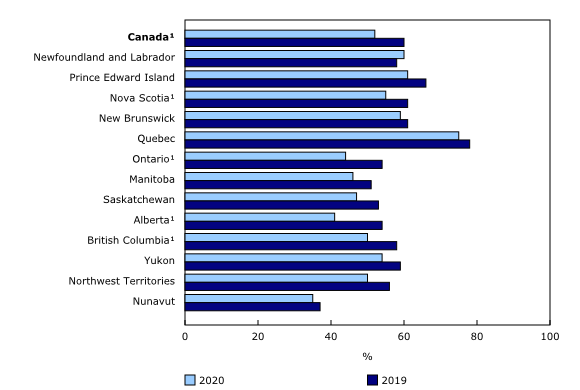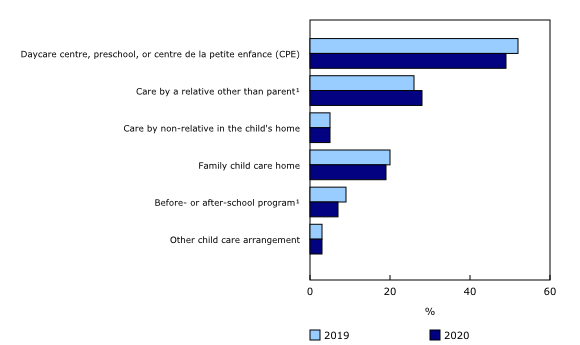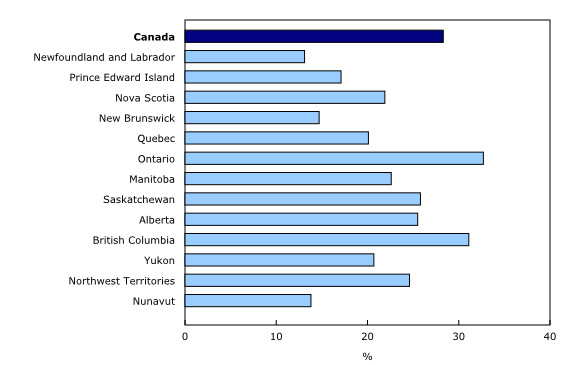Survey on Early Learning and Child Care Arrangements, 2020
Archived Content
Information identified as archived is provided for reference, research or recordkeeping purposes. It is not subject to the Government of Canada Web Standards and has not been altered or updated since it was archived. Please "contact us" to request a format other than those available.
Released: 2021-04-07
Just over half (52%) of Canadian children younger than 6 were in regulated or unregulated child care from November 2020 to January 2021, down from 60% in 2019. In June 2020, early in the COVID-19 pandemic, and at the height of many lockdowns and restrictions on child care, 10% of parents who participated in a crowdsourcing survey reported using child care for their child aged 0 to 5.
These findings from the Survey on Early Learning and Child Care Arrangements (SELCCA) include any form of care for children aged 0 to 5, regulated or unregulated, by someone other than a parent or guardian. Examples include centre-based facilities and care in a home by a relative or non-relative, as well as before- and after-school programs. Occasional babysitting and kindergarten were not considered child care for purposes of this survey.
In the early days of the COVID-19 pandemic, most provinces and territories mandated the closure of licensed child care centres, although limited child care was available for essential workers. The status of regulated and unregulated home child care varied by province and territory, as did the prevalence of COVID-19 cases. However, by late 2020, when the SELCCA data were collected, many child care facilities were operational, albeit with additional safety measures in place, including enhanced health and safety practices and, in some cases, reduced capacity. The survey collection period also coincided with an increase in COVID-19 cases in Canada, particularly in Quebec, Ontario, Alberta and British Columbia.
Children younger than 6 living in Quebec are the most likely to be in child care, and the participation rate is similar to 2019
As was the case in 2019, there were differences in participation rates among the provinces and territories during the pandemic. Children younger than 6 living in Quebec (75%) were most likely to be in child care, a proportion similar to the 78% observed in 2019. By comparison, children aged 0 to 5 living in Alberta were much less likely to be in child care in late 2020 (41%) than in 2019 (54%).
The use of child care also varied by the child's age, although the trends by age group were similar to those in 2019. One-fifth (20%) of children younger than 1 were in some type of child care, compared with three-fifths (60%) of 1- to 3-year-olds. More than half (57%) of 4- and 5-year-olds were in some form of child care, regardless of school or kindergarten attendance, with 63% of children who were not yet in school being in child care and 54% of those in school also in child care.
Daycare centres, preschools and centres de la petite enfance remain the most commonly used types of child care
The types and rates of child care used during the pandemic were similar to those observed in 2019, albeit with slight variations. As was the case prior to the pandemic, daycare centres, preschools and centres de la petite enfance (CPEs) remained the most commonly used type of arrangement (49% of children in child care), followed by care by a relative other than a parent (28%) and family child care homes (19%). Children were slightly more likely to be cared for by a relative in 2020 compared with 2019 and slightly less likely to be in a before- or after-school program.
The age of a child also played a key role in the type of child care arrangement used. For the one in five children younger than 1 in child care, half were cared for by a relative. By comparison, about half of the 60% of children aged 1 to 3 in child care were in a daycare centre, preschool or CPE.
Among those aged 4 or 5 in child care, 65% of those who were not in school or kindergarten were attending a daycare centre, preschool or CPE. Among those aged 4 or 5 in child care and in school, about one-third of those in child care were in a daycare centre, preschool or CPE, and one-third were in a before- or after-school program.
Location is the most commonly cited reason for choosing a specific type of care arrangement
Reasons for choosing a particular child care arrangement were similar before and during the pandemic, with the most common remaining location (cited by 55% of parents using child care), followed by the person providing the care (47%), affordable cost (40%) and hours of operation (36%).
However, at the time of the survey in late 2020, 14% of parents and guardians using child care reported that limited availability during the pandemic was one of the reasons for using their current child care arrangement. The survey did not ask whether parents or guardians needed to or chose to change their arrangement during this time.
Approximately two-fifths of parents using child care during the pandemic report difficulties finding child care
Approximately 4 in 10 parents who were using regulated or unregulated child care in late 2020 reported having had difficulty finding child care. Among parents who self-reported using licensed care as their main child care arrangement, 38% reported having had difficulties finding care, and, among those using unlicensed care (which includes care by a relative), 46% reported at least one difficulty. Parents of 1- to 3-year-olds were the most likely to report difficulties finding child care (41%), while those with children aged 4 or 5 attending school were the least likely to do so (28%).
The majority of parents who were not using care had not looked for child care (63%). However, of those not using child care but who had looked for it, more than half reported difficulties finding care.
In terms of the types of difficulties that parents had, among parents using child care and reporting difficulties finding it, 56% said they had had difficulty finding care in their community, while 43% had had difficulty finding affordable care. Just over one-quarter of these parents said they had had difficulty finding care during the pandemic.
For parents who were not using child care and who reported having had difficulty finding care, 59% said the difficulty was finding affordable care, while 43% had had difficulty finding care during the pandemic.
Having difficulties finding child care can affect parents' ability to work
Difficulty finding child care can result in one or more negative consequences for parents, including their ability to work.
For parents using child care who reported having had difficulties finding it, the most common consequences included changing their work schedule (36%), working fewer hours (31%), or having to use multiple or temporary arrangements (29%). Among parents who had difficulties finding child care and who were not currently using it, 41% had postponed their return to work.
One-quarter of parents not using child care feel that child care is not safe during the pandemic
There were many reasons why parents chose not to use non-parental child care arrangements during the pandemic, yet these reasons largely mirrored those reported in 2019. The most common reasons for not using any child care arrangement (regulated or unregulated) prior to and during the pandemic were that a parent or guardian reported that they had decided to stay at home (37% of those not using child care in late 2020, compared with 43% in 2019), a parent was on maternity or parental leave (25% versus 28% in 2019), or a parent was unemployed (14% versus 16% in 2019). Almost one in four parents (23% in 2020 and 25% in 2019) of children younger than 6 who were not in child care said that the reason was that the cost was too high.
Parents also reported specific reasons for not using child care during the pandemic. More than one-quarter (28%) of parents who were not using any child care said they did not feel it was safe during the pandemic, although there were differences by province and territory. Approximately one in eight parents in Newfoundland and Labrador and in Nunavut who were not using child care said it was unsafe to do so during the pandemic, compared with about one in three parents in Ontario or British Columbia.
Almost one-third (29%) of parents who were not using child care in late 2020 said that they had used it previously, although precisely when they had used child care, as well as the type of care used prior to the pandemic, was not asked.
Looking ahead
The SELCCA provides current information on child care participation during the pandemic that can be compared with patterns of pre-pandemic use. The findings suggest an 8 percentage point decrease in child care participation during the pandemic. However, there are many complexities related to the use and type of care that children may be in during the pandemic; parents may be working at home or have different options available to them because of pandemic-related closures, reopenings, and regulations across the provinces and territories.
These results point to the impact that COVID-19 has had on parents in finding and using child care during these unprecedented times. Child care availability and school closures are an unintended consequence of the COVID-19 pandemic. The economic trade-off of such closures is the increased difficulty for parents, particularly parents with young children, to work. This may especially affect women, who are more likely to bear the weight of child care responsibilities. Furthermore, academic, emotional and social consequences for children because of isolation and the lack of developmental opportunities need further research.
Note to readers
The Survey on Early Learning and Child Care Arrangements (SELCCA) provides a current snapshot of early child care use in Canada, and it can be used to better understand the reasons why families choose to use or not use different types of child care arrangements.
The SELCCA was conducted as part of the Rapid Stats program offered by Statistics Canada's Centre for Social Data Integration and Development to rapidly respond to pressing data needs.
The data were collected in the provinces and territories from November 10, 2020, to January 11, 2021. The response rate was 55% in the provinces and 40% in the territories, yielding a sample size of 10,605 children, which represents about 2.3 million children in Canada. This response rate is similar to those of other Rapid Stats surveys.
The target population was children aged 0 to 5 years, although the information was obtained from a parent, guardian or person who was knowledgeable about the child's care arrangements (or lack thereof). The majority of the respondents were women (91%). Children living in institutions or on reserve were excluded from the target population.
Survey sampling weights were applied to render the analyses representative of Canadian children aged 0 to 5 living in the provinces or territories. Bootstrap weights were also applied when testing for significant differences (p < 0.05) to account for the complex survey design.
New infographic and Early Learning and Child Care Hub are now available
This report is part of on an ongoing series of products released by Statistics Canada related to early learning and child care.
An accompanying infographic "Child care arrangements for children aged 0 to 5 years, 2020" is also available.
All 2019 information and products released to date can be found on the new Early Learning and Child Care Information Hub, also available today. SELCCA data for 2020 will be available Friday, April 9, 2021.
Products
The infographic, "Child care arrangements for children aged 0 to 5 years, 2020," is also available.
Contact information
For more information, or to enquire about the concepts, methods or data quality of this release, contact us (toll-free 1-800-263-1136; 514-283-8300; STATCAN.infostats-infostats.STATCAN@canada.ca) or Media Relations (613-951-4636; STATCAN.mediahotline-ligneinfomedias.STATCAN@canada.ca).
- Date modified:




